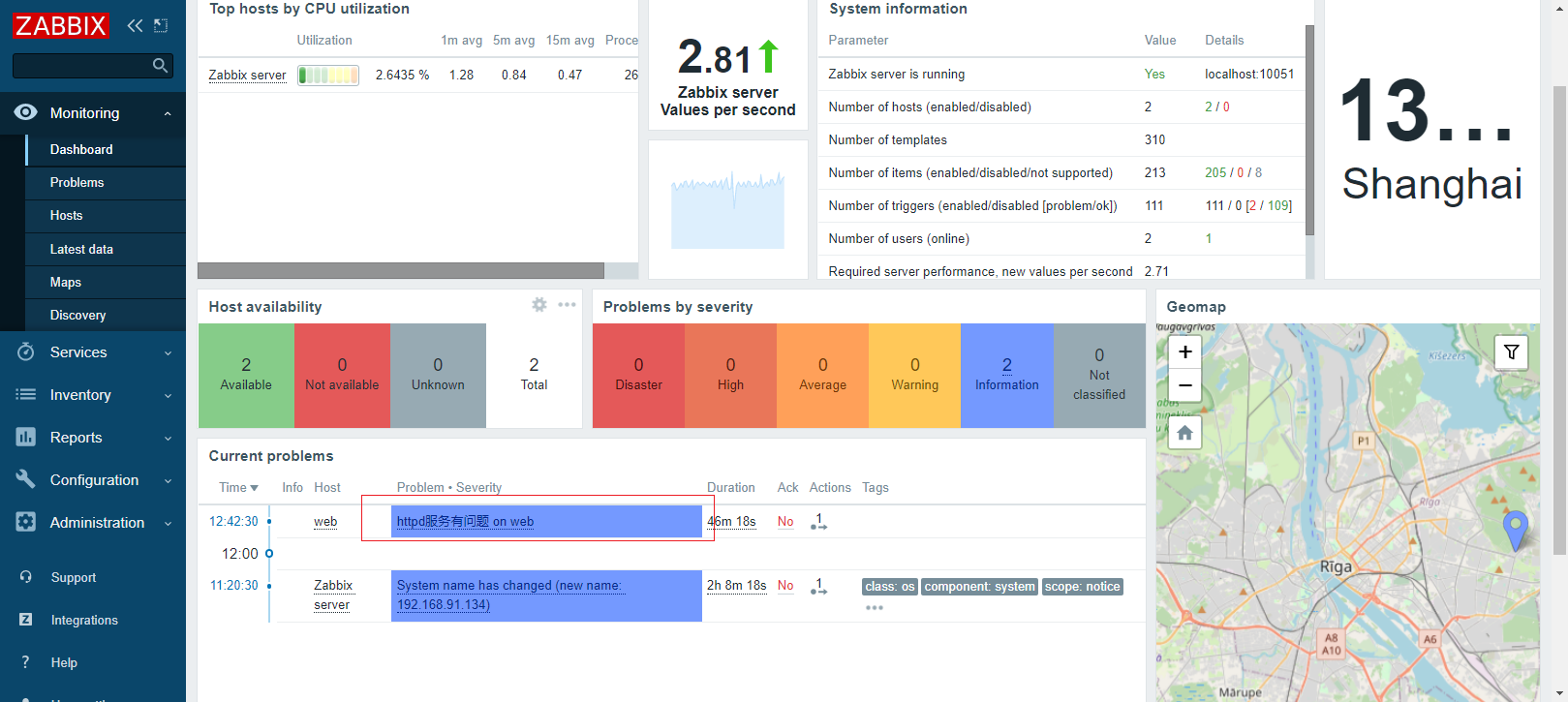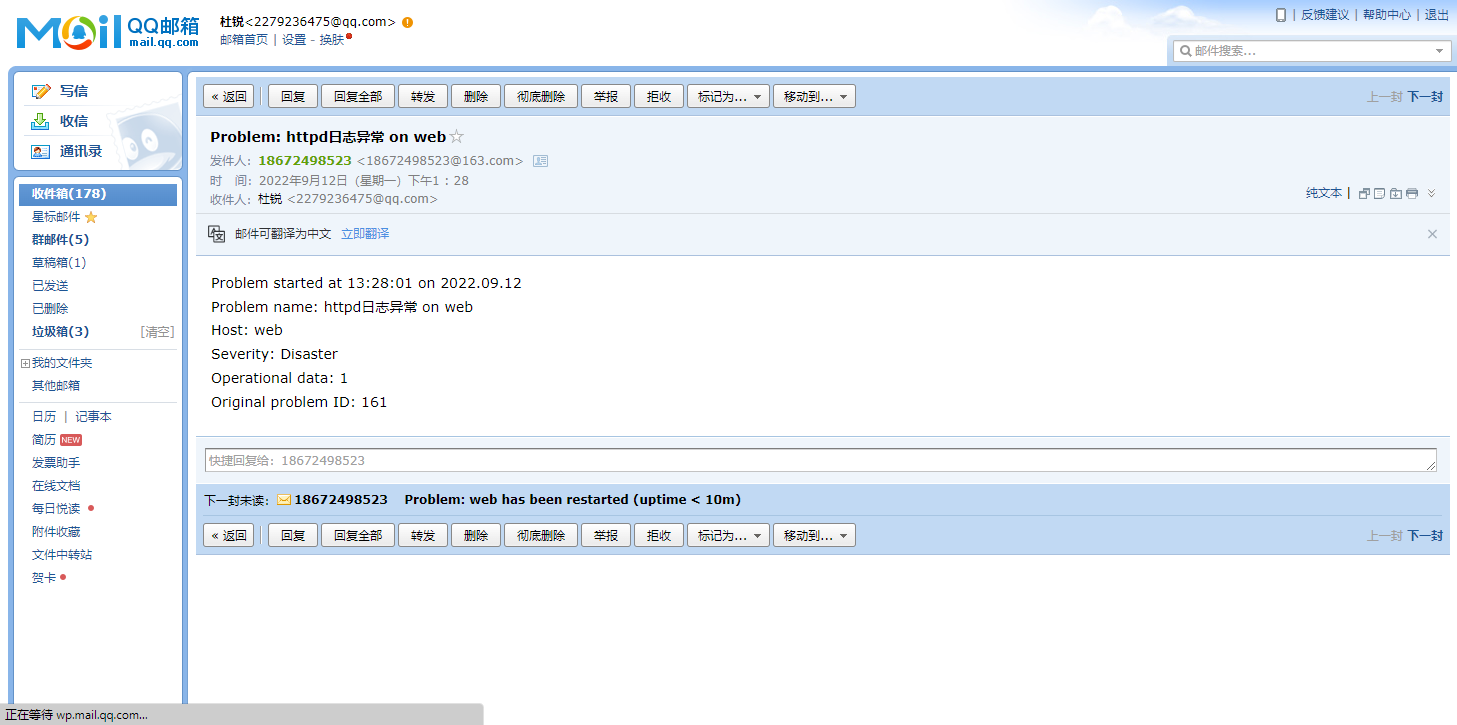环境说明:
操作系统 主机名 IP地址
Centos8(zabbix server) zabbix 192.168.91.134
Centos8(zabbix agent) web 192.168.91.137
进程监控
在agent端编写一个脚本,可以取出需要监控资源的状态值
$()里的这条命令串是过滤$1的进程并用wc -l计数,$1是可键入的值。
$0是去掉grep这条进程的本身
[root@web ~]# mkdir /scripts
[root@web ~]# vim /scripts/check_process.sh
[root@web ~]# cat /scripts/check_process.sh
#!/bin/bash
status=$(ps -ef |grep $1|grep -Ev "$0|grep"|wc -l)
if [ $status -eq 0 ];then
echo '1'
else
echo '0'
fi
//下面这几条意思是,上面一条命令的执行结果等于0则输出1,否则输出0。
//输出1则代表$1的进程数是0,也就是没有进程,说明服务出现问题。
给这个脚本添加执行权限
[root@web ~]# chmod +x /scripts/check_process.sh
[root@web ~]# ll /scripts/
total 4
-rwxr-xr-x 1 root root 133 Sep 12 12:11 check_process.sh
编辑agent端的配置文件
[root@web ~]# vim /usr/local/etc/zabbix_agentd.conf
UnsafeUserParameters=1 #是否启用自定义监控项,可选值为{1|0}
UserParameter=check_process[*],/bin/bash /scripts/check_process.sh $1
重启agent,生效作更改的配置
[root@web ~]# pkill zabbix_agentd
[root@web ~]# zabbix_agentd
//在Server端测试刚刚所做的进程监控配置
//在agent端yum安装一个httpd服务,但没有nginx服务。测试结果如下
[root@zabbix ~]# zabbix_get -s 192.168.92.130 -k check_process[httpd]
0
[root@zabbix ~]# zabbix_get -s 192.168.92.130 -k check_process[nginx]
1
在服务端的zabbix监控页面添加监控项
在配置栏的【Hosts】界面选择给哪台主机添加监控项,点击【items】
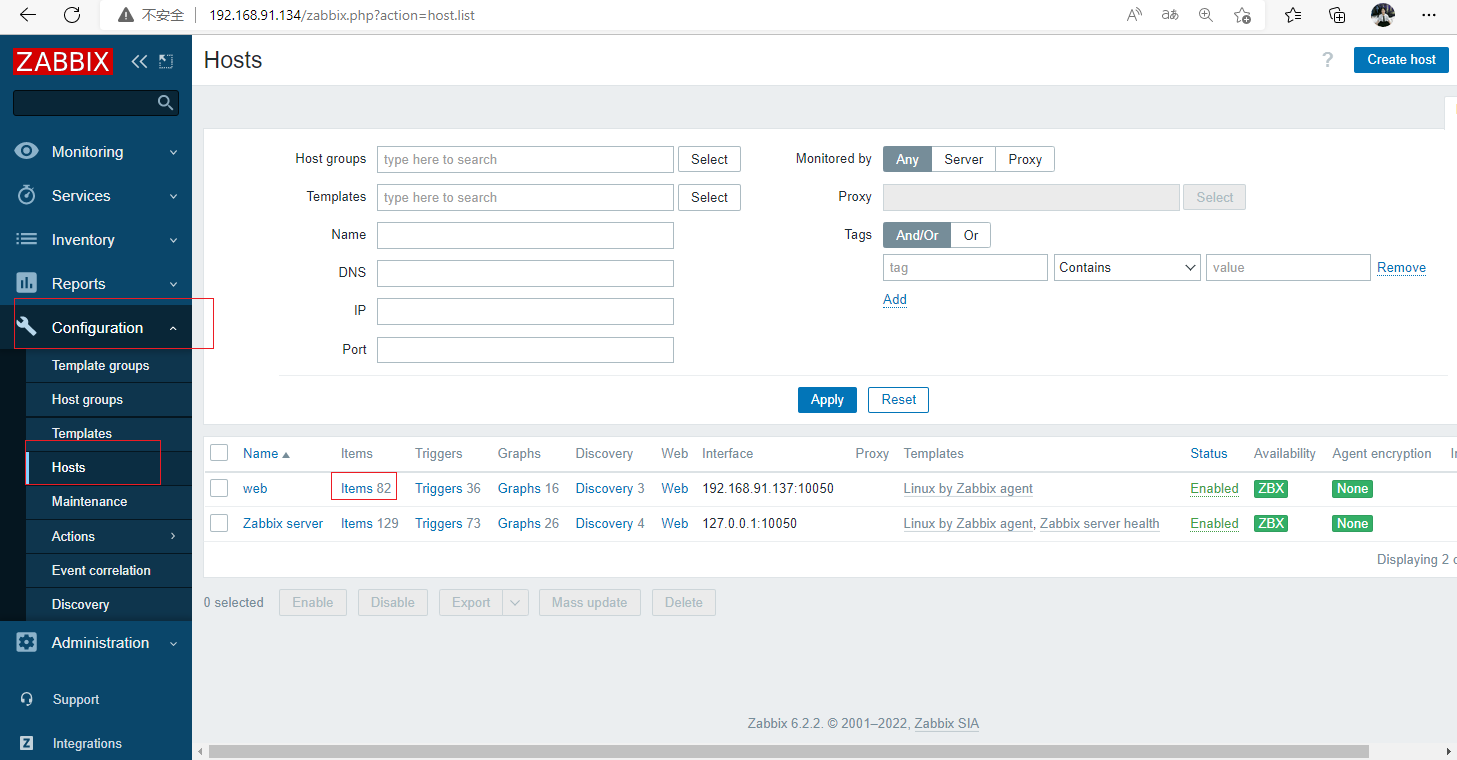
进入【items】界面后点击右上角的【Create item】创建监控项。
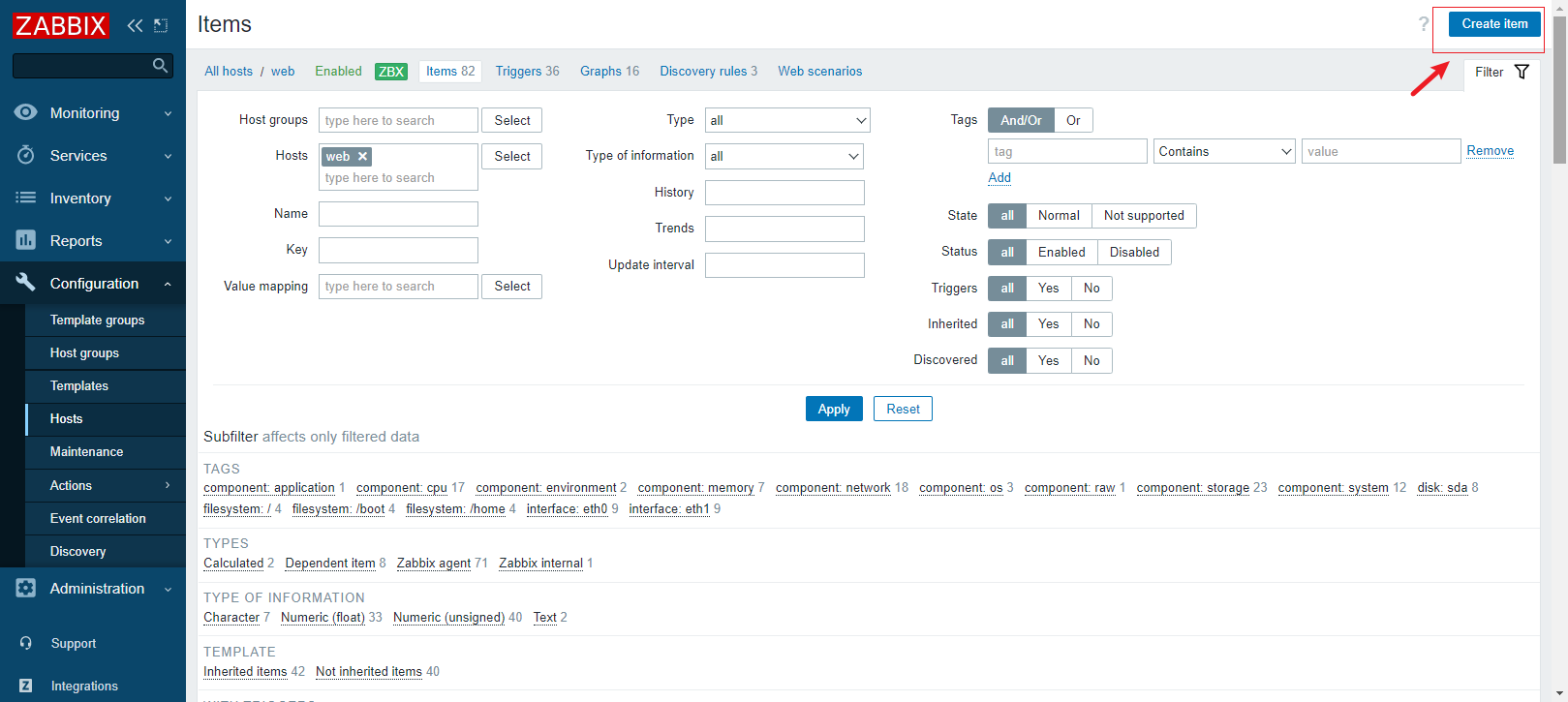
这里的key就是配置文件里的check_process[],我们这里监控httpd进程,就把换为httpd
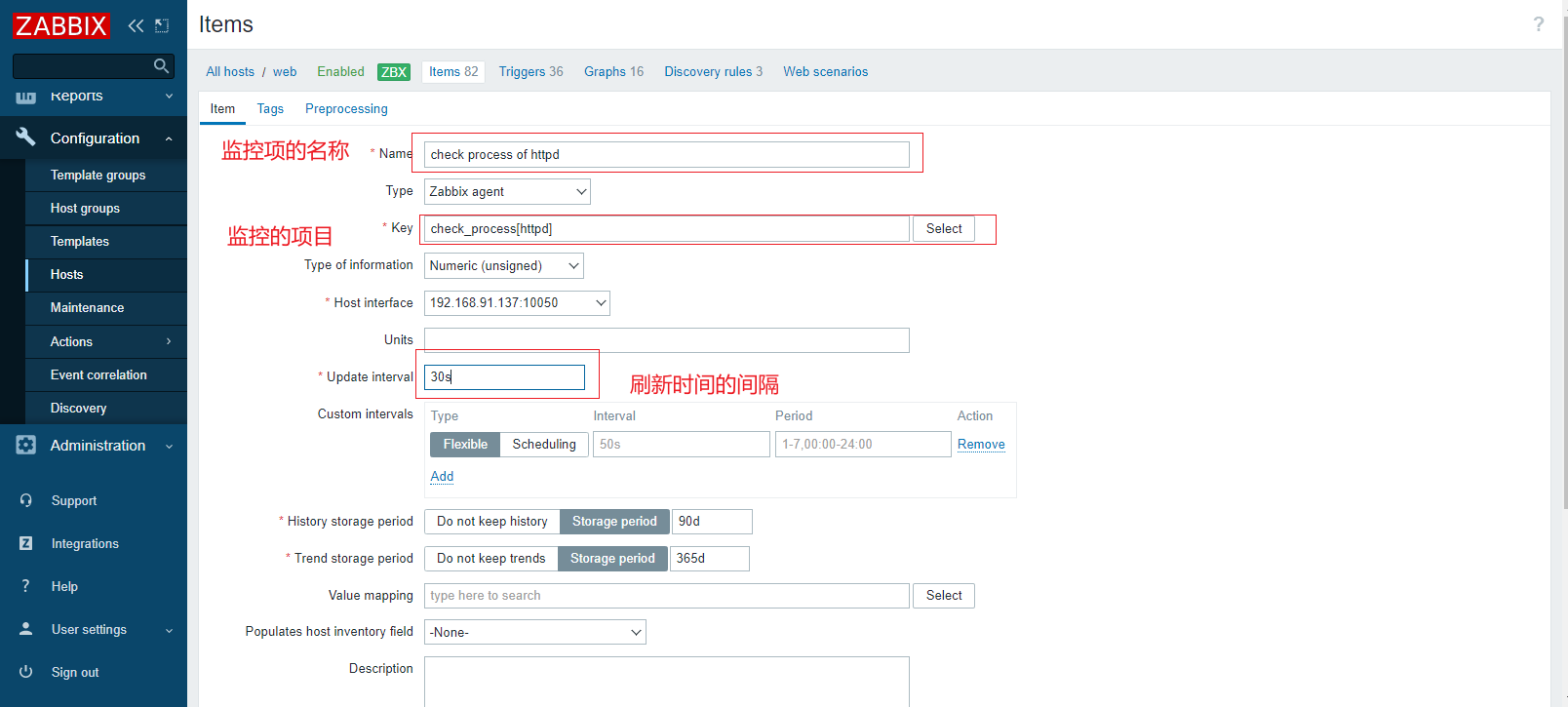
添加触发器
在配置栏的【Hosts】界面选择给哪台主机添加监控项,点击【Triggers】。
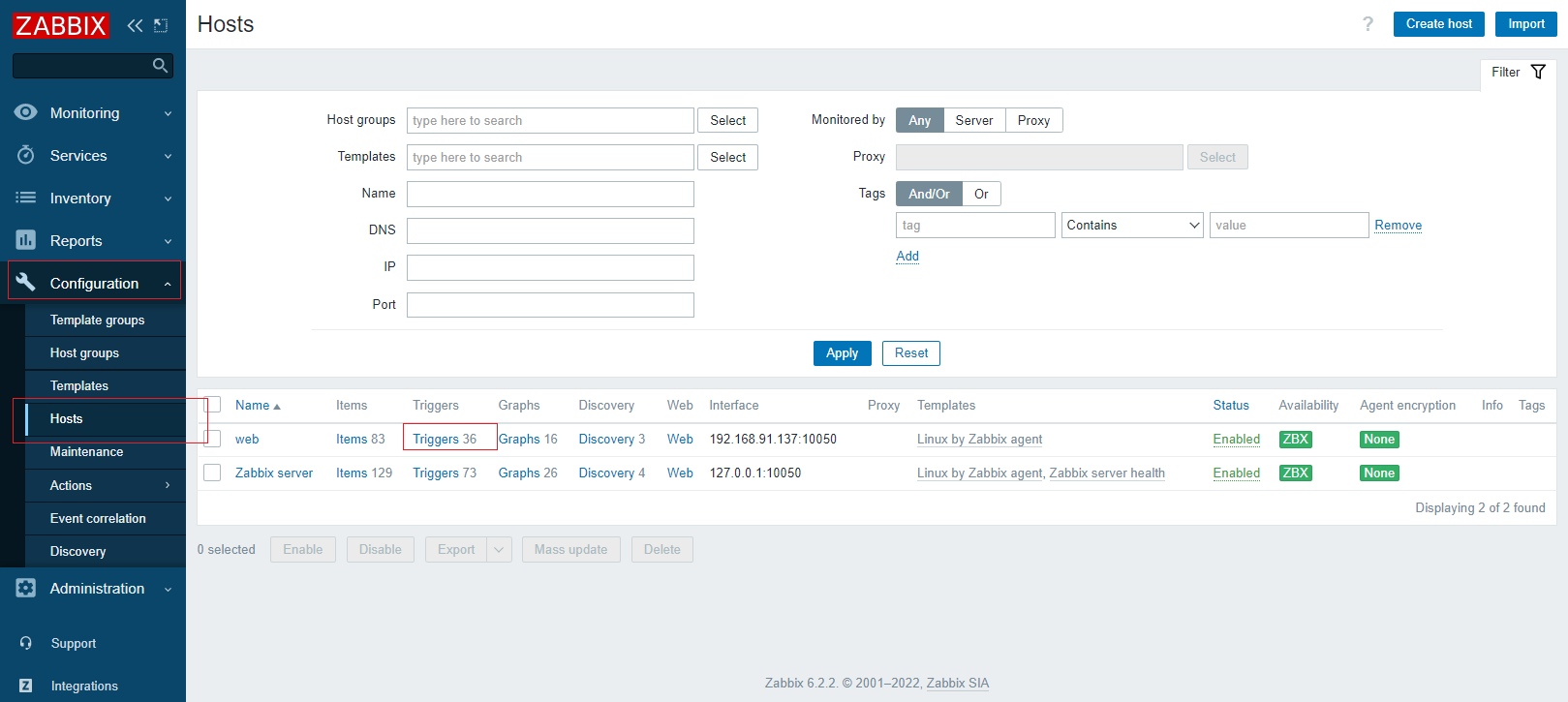
进入【Triggers】界面后,点击右上角的【Create trigger】创建触发器。
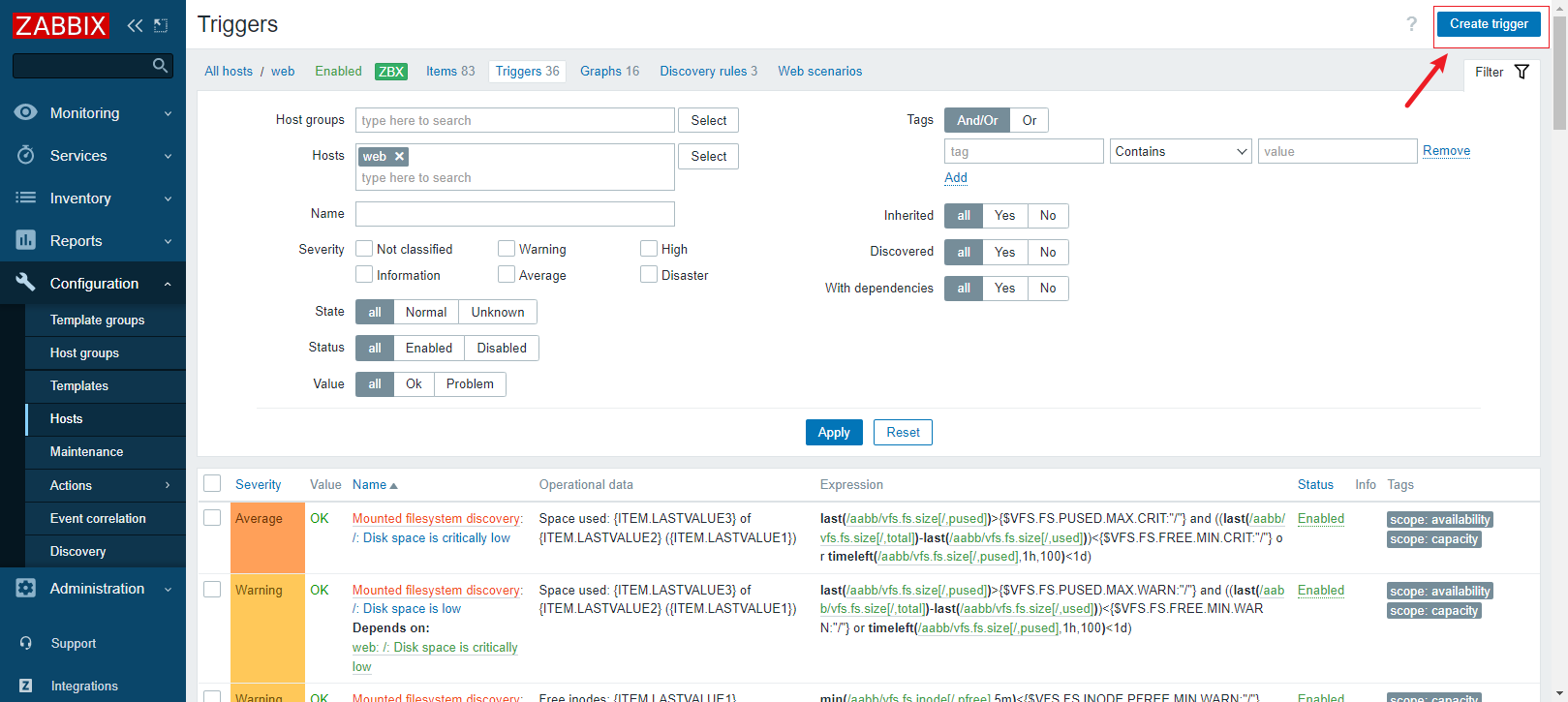
表达式的内容是先点击右边的【Add】进行添加的,添加的内容在下一张图中。
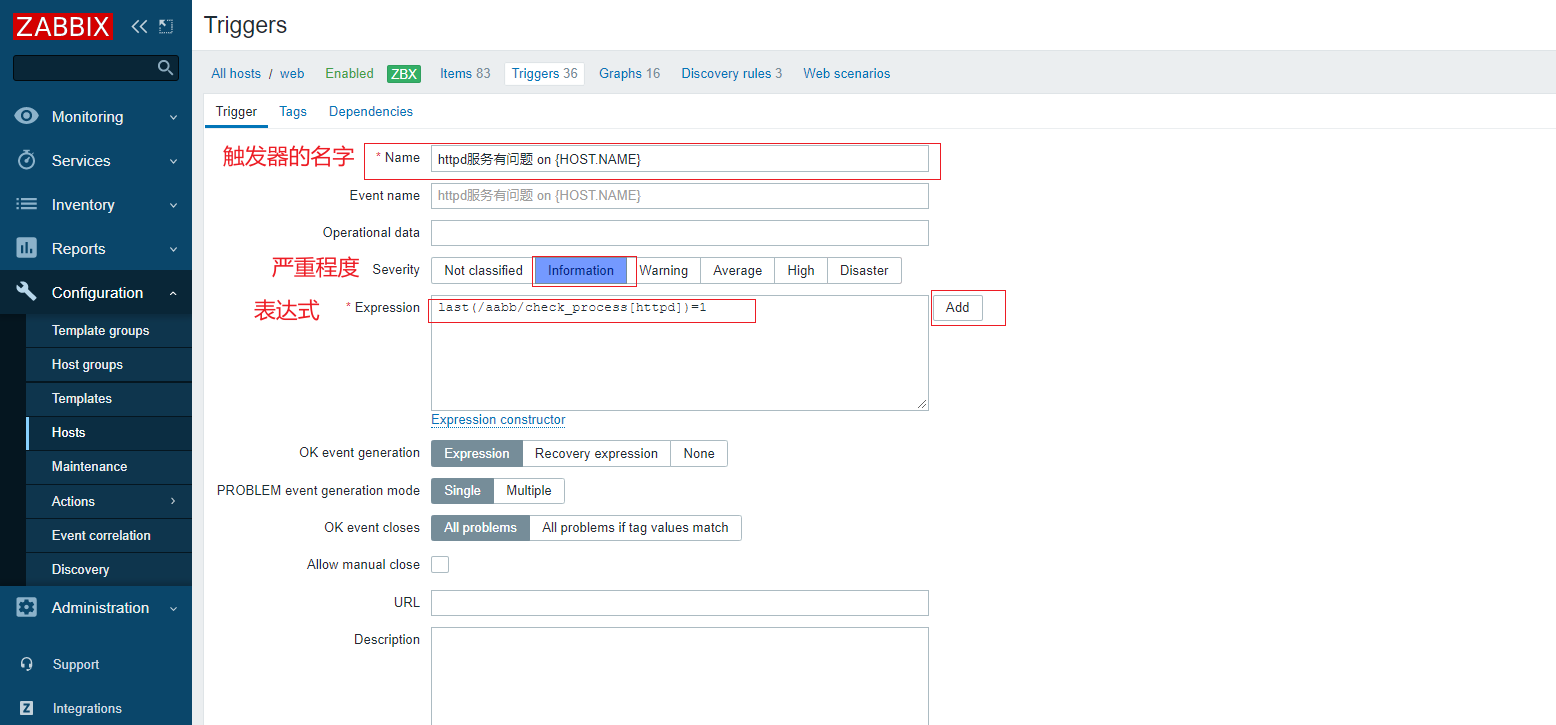
这条表达式是前面配置的脚本中$1键入httpd,如果脚本输出结果等于1则触发告警。
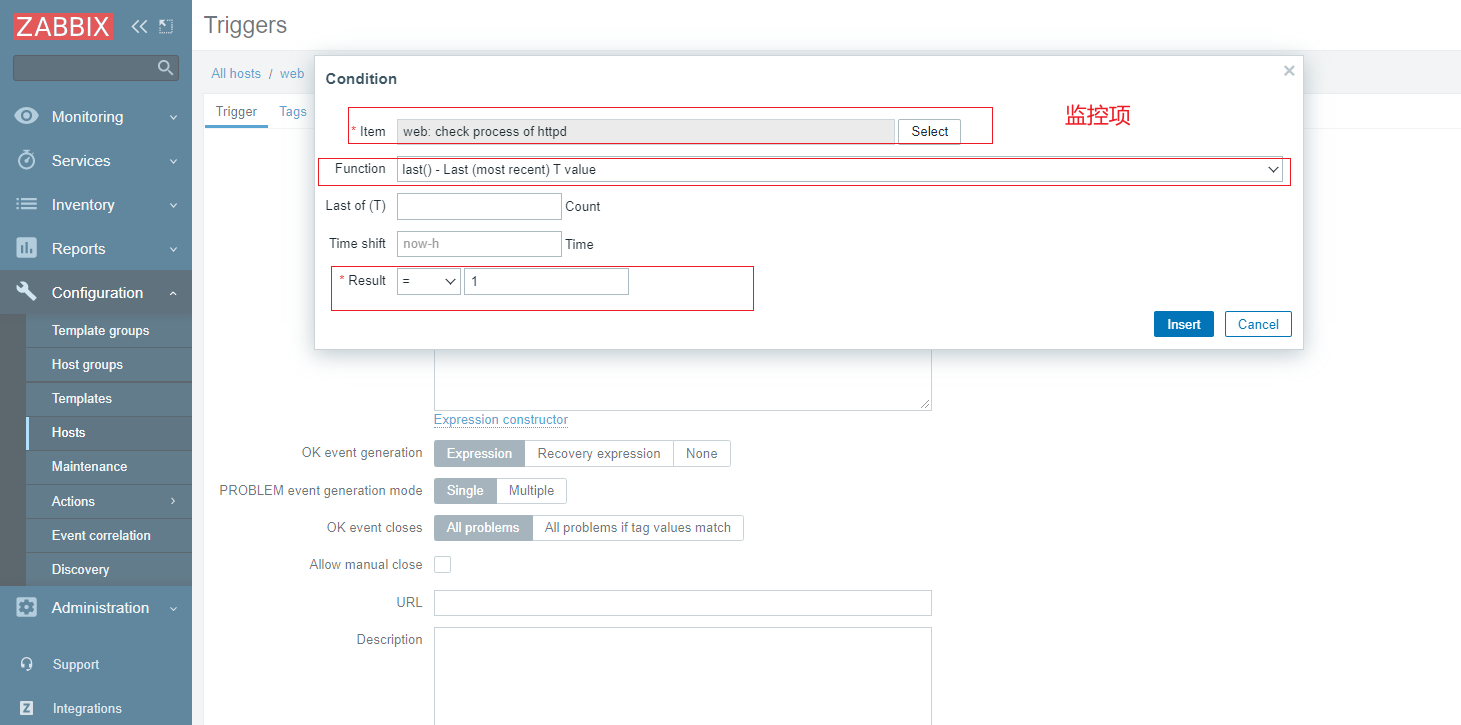
进入配置栏的【Hosts】界面后点击【items】。可以看到这条监控项有了一个触发器。
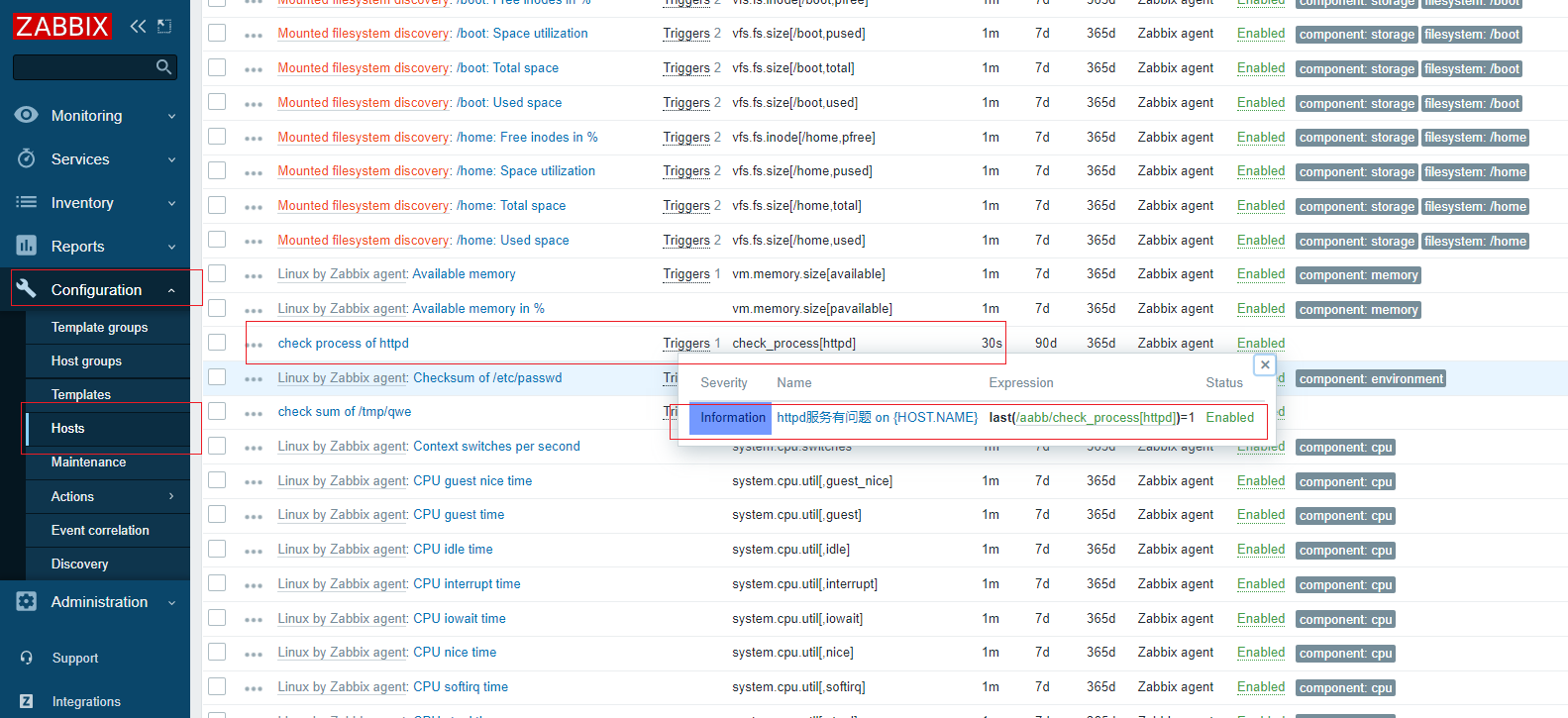
触发验证
手动触发告警,去agentd关闭httpd服务
[root@web ~]# systemctl stop httpd.service
进入监控栏的仪表板界面查看,发现触发了告警
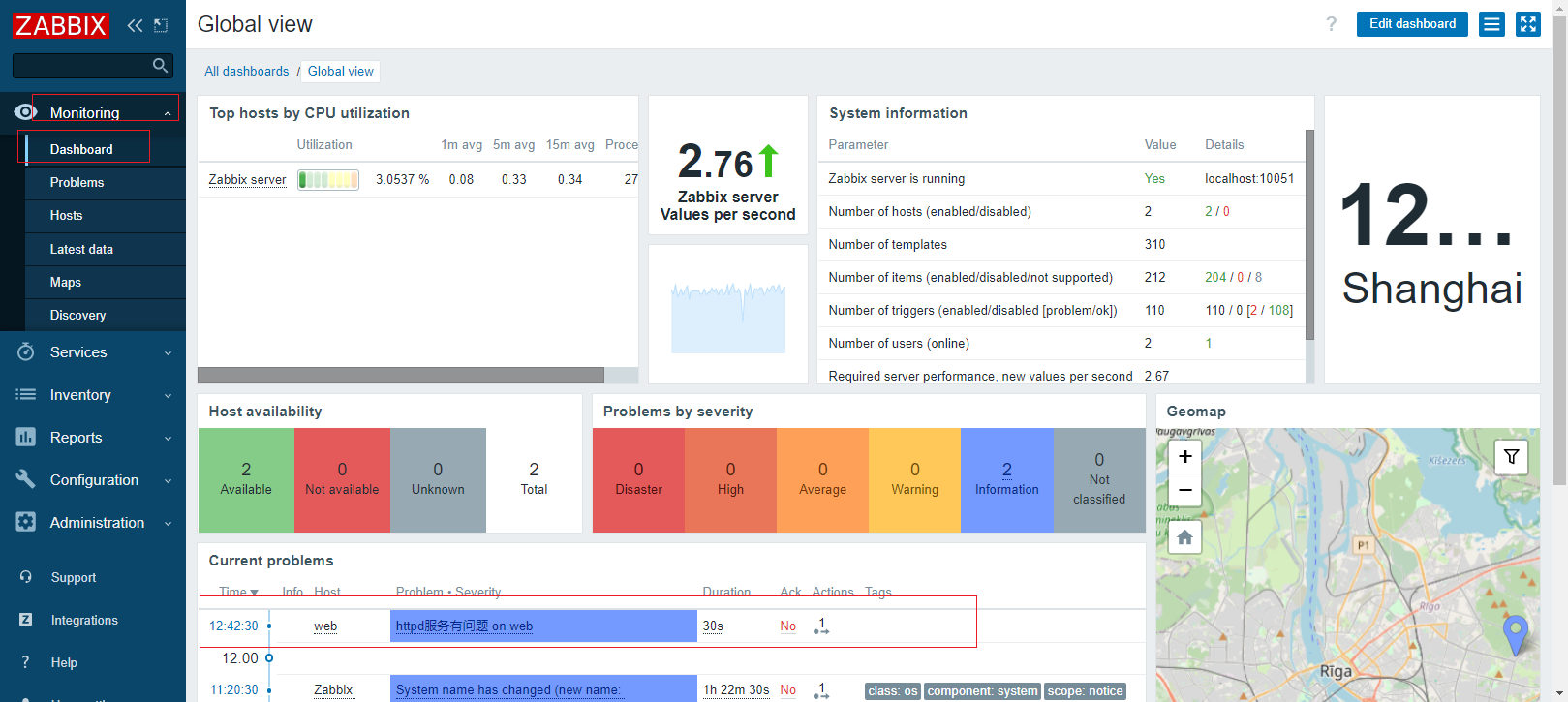
邮箱也发出警告了
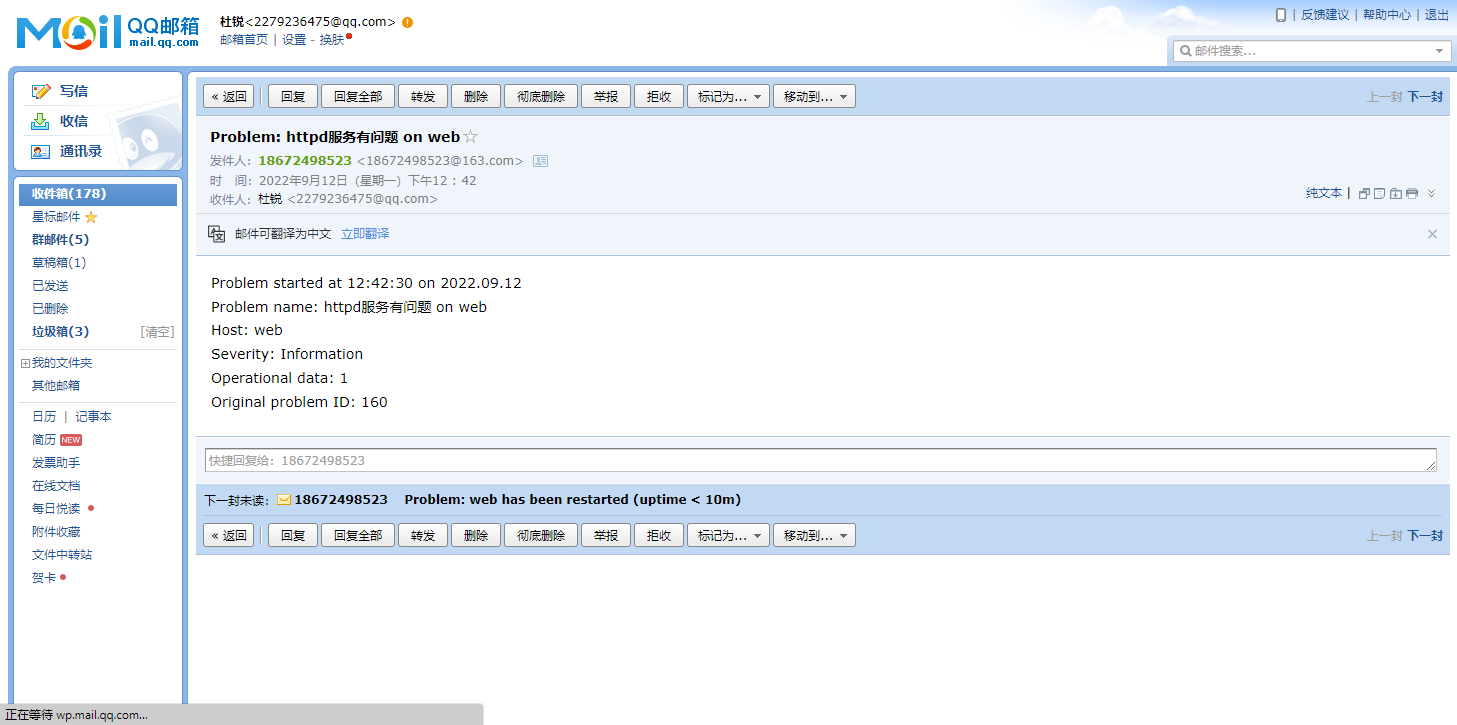
日志监控
在agent端编写脚本,取出需要监控资源的状态值
//下载python的编译器
[root@web01 ~]# dnf -y install python3
//写python脚本。因shell脚本只能在Linux系统执行,如zabbix需要监控Windows系统\
//则需要python脚本,py脚本在这两操作系统都能运行
[root@web ~]# vim /scripts/log.py
#!/usr/bin/env python3
import sys
import re
def prePos(seekfile):
global curpos
try:
cf = open(seekfile)
except IOError:
curpos = 0
return curpos
except FileNotFoundError:
curpos = 0
return curpos
else:
try:
curpos = int(cf.readline().strip())
except ValueError:
curpos = 0
cf.close()
return curpos
cf.close()
return curpos
def lastPos(filename):
with open(filename) as lfile:
if lfile.readline():
lfile.seek(0,2)
else:
return 0
lastPos = lfile.tell()
return lastPos
def getSeekFile():
try:
seekfile = sys.argv[2]
except IndexError:
seekfile = '/tmp/logseek'
return seekfile
def getKey():
try:
tagKey = str(sys.argv[3])
except IndexError:
tagKey = 'Error'
return tagKey
def getResult(filename,seekfile,tagkey):
destPos = prePos(seekfile)
curPos = lastPos(filename)
if curPos < destPos:
curpos = 0
try:
f = open(filename)
except IOError:
print('Could not open file: %s' % filename)
except FileNotFoundError:
print('Could not open file: %s' % filename)
else:
f.seek(destPos)
while curPos != 0 and f.tell() < curPos:
rresult = f.readline().strip()
global result
if re.search(tagkey, rresult):
result = 1
break
else:
result = 0
with open(seekfile,'w') as sf:
sf.write(str(curPos))
finally:
f.close()
return result
if __name__ == "__main__":
result = 0
curpos = 0
tagkey = getKey()
seekfile = getSeekFile()
result = getResult(sys.argv[1],seekfile,tagkey)
print(result)
[root@web ~]# chmod +x /scripts/log.py
[root@web ~]# ll /scripts/
-rwxr-xr-x 1 root root 1854 Sep 12 12:51 log.py
[root@web ~]# /scripts/log.py /var/log/httpd/error_log
0 //测试一下该脚本是否可用,0代表没问题
//关于该文件请往下看写的log.py脚本的注释
[root@web ~]# cat /tmp/logseek
1023 //该数字记录着读取到哪儿了
/用例子来说明2915这个数字是怎么来的
[root@web ~]# echo "test" >> /var/log/httpd/error_log
[root@web ~]# echo "test" >> /var/log/httpd/error_log
[root@web ~]# echo "test" >> /var/log/httpd/error_log
//执行脚本检查httpd的错误日志
[root@web ~]# /scripts/log.py /var/log/httpd/error_log
0
//执行完脚本后,可以看到该文件的数字串发生了变化,相较之前的数+15了\
//多出来的15是因为前面往那个文件追加了三行test,4个字母乘以3加上三个换行符=15
[root@web ~]# cat /tmp/logseek
1038
//手动添加错误信息"Error"测试效果
[root@web ~]# echo "Error" >> /var/log/httpd/error_log
[root@web ~]# /scripts/log.py /var/log/httpd/error_log
1
log.py脚本注释
作用:检查日志文件中是否有指定的关键字
第一个参数为日志文件名(必须有,相对路径、绝对路径均可)
第二个参数为seek position文件的路径(可选项,若不设置则默认为/tmp/logseek文件。相对路径、绝对路径均可)
第三个参数为搜索关键字,默认为 Error
在agentd端编辑配置文件
[root@web ~]# vim /usr/local/etc/zabbix_agentd.conf
UserParameter=check_log[*],/scripts/log.py $1 $2 $3 //添加这一条日志监控
//重启agent,生效配置
[root@web ~]# pkill zabbix_agentd
[root@web ~]# zabbix_agentd
[root@web ~]# ss -anlt
State Recv-Q Send-Q Local Address:Port Peer Address:Port Process
LISTEN 0 128 0.0.0.0:10050 0.0.0.0:*
LISTEN 0 128 0.0.0.0:111 0.0.0.0:*
LISTEN 0 128 0.0.0.0:22 0.0.0.0:*
LISTEN 0 128 [::]:111 [::]:*
LISTEN 0 128 [::]:22 [::]:*
//配置生效之后,去服务端测试
测试之前先做些测试的准备工作
设置文件权限。因为zabbix服务端访问客户端属于其他,如果
文件的其他人没有读的权限,则无法监控该项
[root@web ~]# ll /var/log/httpd/error_log
-rw-r--r-- 1 root root 1044 Sep 12 12:57 /var/log/httpd/error_log
[root@web ~]# ll -d /var/log/httpd/
drwx------. 2 root root 4096 Aug 2 09:39 /var/log/httpd/
[root@web ~]# chmod 755 /var/log/httpd/
[root@web ~]# ll -d /var/log/httpd/
drwxr-xr-x. 2 root root 4096 Aug 2 09:39 /var/log/httpd/
//因之前本地测试脚本生成了该文件,该文件的属组是本地的root用户
//需本地测试完后删掉,在server执行脚本生成新的文件
[root@web ~]# ll /tmp/logseek
-rw-r--r-- 1 root root 4 Sep 12 12:57 /tmp/logseek
[root@web ~]# rm -f /tmp/logseek
服务端测试
[root@localhost local]# zabbix_get -s 192.168.91.137 -k check_log['/var/log/httpd/error_log']
1 //会输出1是因为之前测试往httpd的error_log文件追加了‘Error’,前面又把测试的logseek记录检查文件给删除了,这是执行脚本会生成新的logseek文件,该文件会从头开始,所以检测出‘Error’
//再次执行就不会输出1了,因为再次检测从上次检测的尾部之后开始,故当前error日志没有‘Error’信息
[root@localhost local]# zabbix_get -s 192.168.91.137 -k check_log['/var/log/httpd/error_log']
0
//去到agent查看新生成的logseek记录检查文件,可以看到属主是zabbix
[root@web ~]# ll /tmp/logseek
-rw-rw-r-- 1 zabbix zabbix 4 Sep 12 13:11 /tmp/logseek
在zabbix服务端web界面添加监控项
跟添加进程监控的步骤流程一致,只需改变些操作,具体可以参考上面的
添加触发器
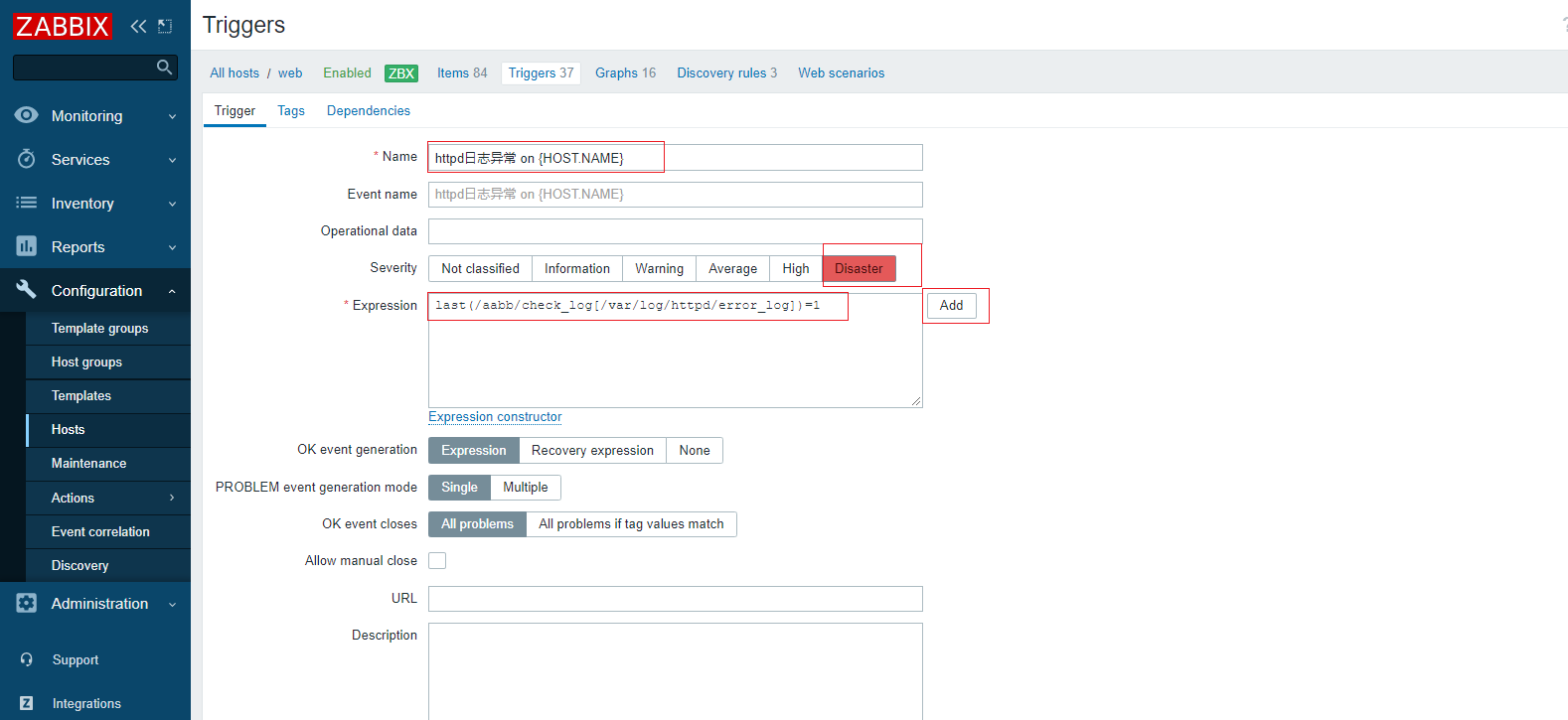
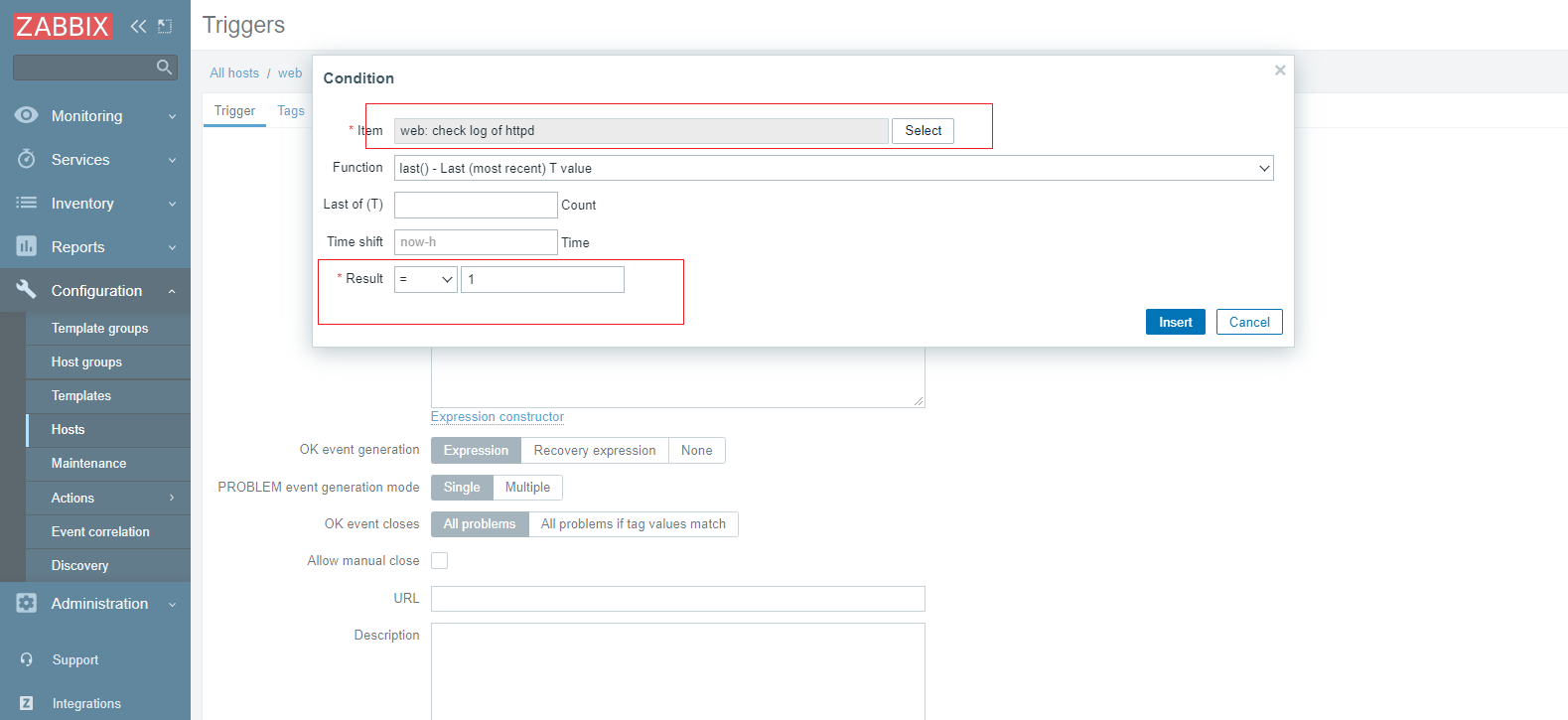
触发验证
手动触发告警
[root@web ~]# echo 'Error' >> /var/log/httpd/error_log
进入监控栏的仪表板界面查看,发现触发了告警,邮箱也收到了告警信息。
